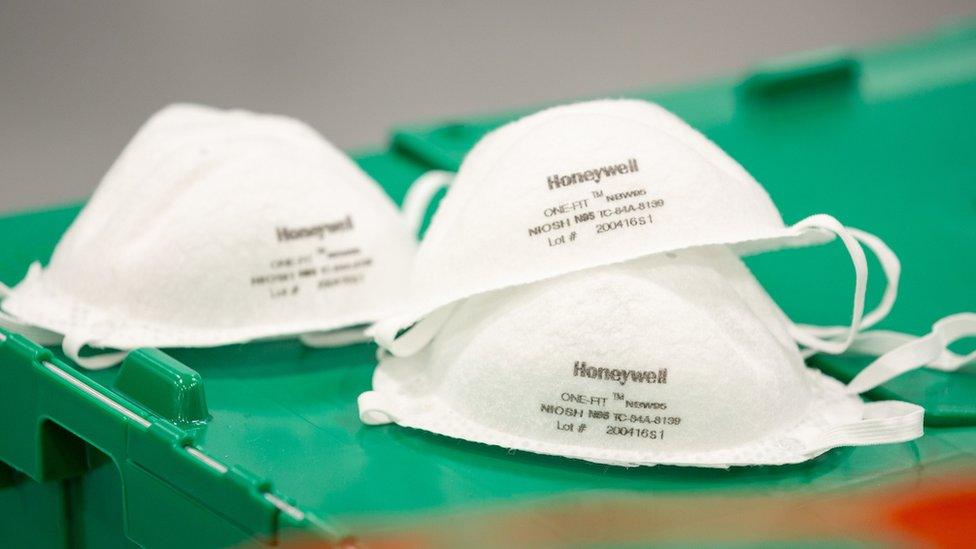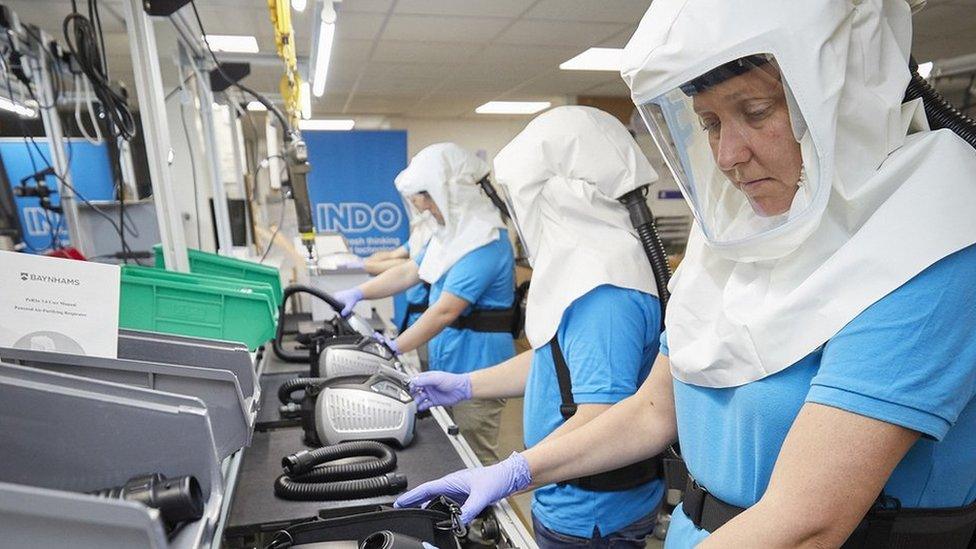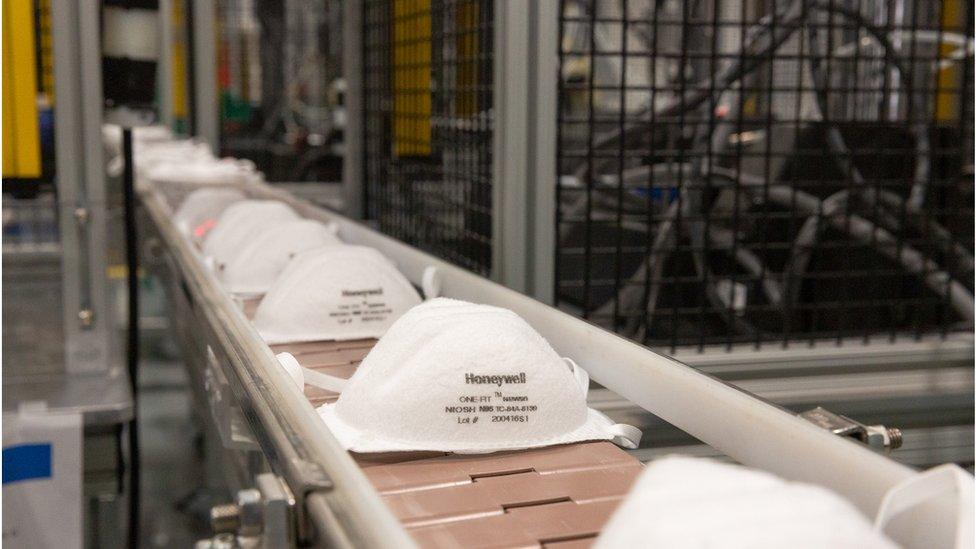Find out which masks offer the most protection and why
- Published

Facemasks in use at University Hospital Southampton
While paper and cloth masks may help controlling the spread of Covid-19 amongst the general public, they're certainly not up to the mark for use in intensive care.
Here, where the risk of infection is at its greatest, medical staff need personal protective equipment of a far higher standard, capable of shielding them completely from the virus.
The simplest form of face covering is the surgical mask, generally made of three layers of paper or cloth. They're resistant to droplets such as those caused by coughing or sneezing, but give little protection against viral particles themselves, which are only around 100 nanometres in size (a nanometre being a billionth of a metre).
"A mask, which goes over your nose and mouth, but doesn't fit tightly to your face, is really there to be a barrier for any particles that you might expel," explains Dr Nikki McCullough, head of safety for 3M, one of the world's biggest suppliers of respiratory protection. "The mask isn't going to prevent you from breathing in very small particles."

Medical staff working in intensive care need the highest-rated masks
Respirators, on the other hand, are designed to fit tightly to the face, so that no air can leak in or out, and require a rigorous fitting process.
"When you breathe in, all the air goes through the filter media, and that filter media has been tested to a performance standard," says Dr McCullough. "So you can be sure that if you get a good seal to your face, the respirator is reducing the number of particles that you're going to breathe into your lungs."
Respirators come in various different forms, the simplest being mask-like filtering facepiece (FFP) respirators; some are designed to be disposable, whereas others can be disinfected and reused.


In the US, FFP respirators are classified by the National Institute for Occupational Safety and Health (NIOSH) in terms of the percentage of particles they filter out. Thus, N95 and N99 masks filter out 95% and 99% of particles respectively, while N100 devices eliminate 99.97%.
In Europe, respirators are classified slightly differently. Respirators rated FFP1 filter out at least 80% of particles; FFP2s remove at least 94%, and FFP3 devices correspond to N100 by filtering out at least 99.97%.
Meanwhile, similar to an FFP3 mask in effectiveness, but certainly not in appearance, are diving helmet-style powered air purifying respirators (PAPRs).
"There you have a more comprehensive solution. There's a hood face shield and a tube that would connect into a unit on the belt," says Brian Hovey, chief marketing officer for major respirator manufacturer Honeywell.

Respirators are available with a range of filtering levels
"That has an engine or a motor that pumps air through a filter: it's part of a white suit, so it's a more comprehensive protective solution."
At the University of Southampton, engineers have developed a PAPR that they're supplying to University Hospital Southampton - 1,000 are already in use.
It's currently undergoing the official rating and approval process, so it's not yet in use in intensive care or triage, where FFP3 respirators are required. However, two firms are making them and 5,000 have been ordered for staff in other settings.
The testing process involved both a smell test to see whether the wearer could detect outside smells, as well as a physical test of whether tiny particles are indeed filtered out.
"We put a petri dish inside the hood and another one outside, and delivered 1,000 litres of air through the filter," explains Alex Dickinson, an associate professor in the university's bioengineering science research group.
"We incubated them for 24 hours at 37C and then counted how many of these colony-forming units had been transmitted through the filter and hood. On our first experiment, we saw no units of bacterial growth inside the hood, but ten formed on the control plate outside."
The British Standards Institute is currently evaluating the device against European standards, after which, hopes the team, it can be used more widely at Southampton and elsewhere.
"Your vision is much better, and your communication is better, as the patient can see your whole face; your efficiency is much better as you can move from patient to patient without putting on and taking off your PPE," says hospital consultant and professor in respiratory medicine Paul Elkington.

A mask developed by the University of Southampton is under production
"Once we started rolling it out, one of the healthcare assistants said to me 'I've been feeling sick with nerves about coming in, but now I feel secure'."
Until recently, the market for respirators was mainly industrial - manufacturing, construction and the like.
"If we look at six months ago, with full-face respirators - FFP2s and FFP3s - demand from healthcare was very low," says Dr McCullough. "They really only used them for tuberculosis, maybe a measles case. But now we see that healthcare everywhere in the world is using respirators at a much, much higher rate."
As a result, manufacturers have been working flat out to increase capacity to meet the new demand.
"We've made significant investment in both ramping up capacity at our existing facilities as well as new facilities. Most notably, in the US, we've just had our first products coming off the line in our Smithfield, Rhode Island facility, and we hit 500,000 units earlier this past week," says Honeywell's Brian Hovey.
"Similarly, we've ramped up our build capacity and we're starting to get product out in Phoenix. These new facilities are adding about 20 million units per month, and we're evaluating potential new facilities around the globe."

Honeywell has boosted production of masks
Dr McCullough says that 3M is also increasing production, adding extra shifts and improving efficiency.
"We can make the same products but more quickly; we are adding new lines and we are looking at some small changes to certain products, looking at new headbands, for example," she says.
So will the global supply hold up?
"In the immediate term, probably not, unfortunately - the uptick we've seen has been unprecedented and depending on how people are thinking of them as a consumer product, demand far outstrips global supply," says Mr Hovey.
But, he adds, "We're having a good dialogue with governments around preparing for the future, and we make sure that strategic stockpiles are adequately supplied.
"If - god forbid - another situation like this occurs, collectively we'll be able to respond quickly and effectively."

A SIMPLE GUIDE: How do I protect myself?
VACCINE: How close are we to finding one?
AVOIDING CONTACT: The rules on self-isolation and exercise
LOOK-UP TOOL: Check cases in your area
TESTING: Can I get tested for coronavirus?
